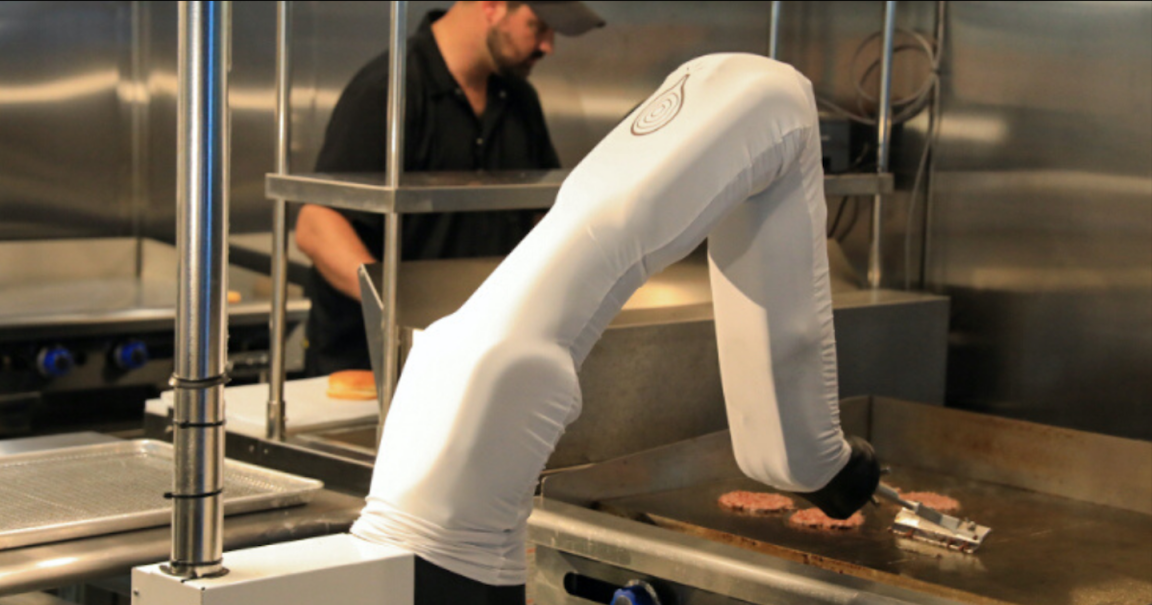
Dining out looks pretty different these days. It’s natural to pine for the past, but many quick service restauranteurs are also looking ahead to a future where automation will be the key to drastically increasing their notoriously thin margins and allowing their workers to shine in the tasks no machine can do.
Robots in the workplace can get a bad rap—most people aren’t trying to get replaced by one. But the smartest and most innovative robotic companies aren’t designing teams of droids that send people packing. Instead, they’re crafting intelligent machines that work alongside workers, increasing efficiency and profits in the process.
Take Flippy, the arm-like robotic kitchen assistant from Miso Robotics. As its name implies, the robot flips burgers, cooking them to perfection. Miso Robotics has already raised over $2mm in their investment campaign on SeedInvest, which is still open to investors. The company also recently unveiled Flippy’s newer, more versatile cousin, Robot on a Rail (ROAR). Suspended from an overhead railing rather than standing on the floor, the machine can perform tasks like frying onion rings and preparing chicken tenders. When the orders are ready, it lets its co-workers know, and can clean up after itself by doing dirty and time-consuming jobs like scraping down grills.
Both are AI-enabled, allowing them to take in their surroundings and learn and evolve over time. They know what time to start cooking a well-done burger so that it’s done at exactly the same time as a medium-rare burger for the same order, or could learn how to optimize oil use to minimize waste, for instance.
In a pre-pandemic time of restaurant labor shortages, Flippy kept kitchen productivity high and costs low, a giant deal in an industry known for tiny margins. Introducing Flippy into a kitchen can increase profit margins by a whopping 300%, not to mention significantly reduce the stress managers feel when trying to fill shifts.
But even if restaurants have an easier time finding workers as places reopen, Flippy and ROAR aren’t gunning for people’s jobs. They’re designed to be collaborative robots, or cobots, the cost-effective machines created to work with humans, not against them.
Robots are great at efficiency and mindless tasks. They don’t complain about fried food grease getting in their pores, walk out on the job when they’re too bored to flip another burger or burn the chicken tenders after getting distracted by a cute coworker.
But they also can’t greet regulars by name, upsell customers, or expertly calm unhappy guests. Quick service restaurants with tools like Flippy and ROAR are the kind of places you keep coming back to—you know the staff will always have time to answer your detailed questions or joke with your child as they hand them a special kids menu, and you can also trust your order will always be right on time, perfectly cooked, and made just the way you like it.
Automation in restaurants will become even more crucial post-pandemic when owners will potentially need workers to enforce updated safety regulations and interact with disgruntled guests. It may not be an easy job for those workers, but with Flippy having their back in the kitchen, they’ll know they won’t have to worry about burnt burgers on top of confused customers. Flippy is already hard at work in places like Dodger Stadium and more than 50 CaliBurger restaurants, having perfectly cooked more than 12,000 burgers.
Previously, investment opportunities like this were only available to the ultra-wealthy and uber-connected, leaving everyday investors with the soggy, leftover fries. But now, you can get in on the ground floor of a potential high-growth opportunity like investing in Miso Robotics. Check out the company’s website for more information on how you can be a part of a company primed to leverage robotics and AI and lead quick service restaurants into the future with the world’s first autonomous robotic kitchen assistant
Futurism fans: To create this content, a non-editorial team worked with our partners at Miso Robotics. This post does not necessarily reflect the views or the endorsement of the Futurism.com editorial staff.